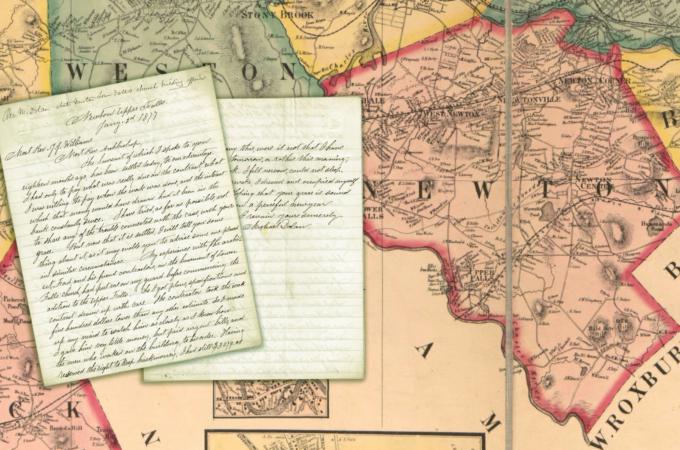A lawsuit over the construction of St. Mary Church, Newton Upper Falls
On Jan. 2, 1877, Father Michael Dolan, pastor of St. Mary in Newton Upper Falls, wrote to Archbishop John J. Williams, informing him that for the past 18 months he was involved in a lawsuit which had been settled in his favor earlier that day. "I have tried, as far as possible, not to share any of the trouble connected with the case, with your grace," Father Dolan writes, "but now that it is settled, I will tell you something about it, as it may enable you to advise some one placed in similar circumstances."
The first Catholic Mass is believed to have been celebrated in Newton around 1832 by Father Thomas O'Flaherty and the first in Upper Falls by Father James Strain of Waltham about 12 years later. In the ensuing years, the area was visited irregularly by priests from Waltham and Watertown, and soon became a mission of the latter. By 1860, the Catholic population grew enough to warrant regular weekly visits by a priest, a transition from worship in private homes to public halls and the raising of funds for a church.
In 1864, Father John McCarthy of Watertown purchased a lot on Chestnut Street, where a small wooden church was constructed and dedicated to St. Mary on Nov. 17, 1867. It became a separate parish, independent of Watertown, on April 10, 1871, which served all Catholics in Newton, south of Beacon Street, all of Needham, and parts of Wellesley.
The first pastor was Father Michael X. Carroll, but after only a few months he was succeeded by Father Dolan on Dec. 4, 1871, described by historians as a "zealous and indefatigable priest" and "a man of enormous energy and foresight." He made extensive improvements to the church, adding a basement, installing a new roof, enlarging the main church to increase capacity, and embellishing its interior. Following completion of the work, the church was rededicated on April 30, 1876 -- though the project did bring about the lawsuit referenced in Father Dolan's January 1877 letter.
He relates to Archbishop Williams that his suspicion of the architect and contractor were raised after the first phase of the project was completed, the basement or lower church. This caused him to take precautions, including obtaining written copies of the plans, specifications and the contract. He also only paid as work was completed, disbursing funds to the laborers directly, or buying necessary materials, withholding a final sum due to the contractor until work was completed.
Essentially, the contractor failed to disperse funds to those he employed for services. One of them was a "Mr. Paul," who attempted to sue Father Dolan for $900 he claimed was owed to him. Father Dolan admits that Mr. Paul did complete the work he was hired for; however, the money in his possession was not designated for that purpose and should have been paid by the contractor. Father Dolan first considered resolving the situation privately but was advised if he did so a lawsuit could still be brought against him and he might be forced to pay twice, and was so convinced to let legal proceedings settle the matter.
An auditor was appointed to review the case, Mr. Paul claiming that bills were sent to Father Dolan and never returned with payment. Fortunately, Father Dolan demonstrated his administrative skills and was able to produce documents showing the contractor agreed to pay the bills in question, and a letter from Mr. Paul's clerk apologizing for sending him the bills in error. In addition, Mr. Pauls' foreman confessed that he and his colleagues were compensated for their time directly by Father Dolan, as agreed, so they were not owed anything further.
The affair was exhausting for Father Dolan, he reveals that his own statement and the cross-examination of witnesses took three days -- the initial trial amounting to about two weeks total. It was appealed and appeared before a superior court several times, each time requiring a "long statement which covered all the transactions and conversations, as far as I could remember, of a whole year, as far as they related to the case." For about 20 days, he sat, from morning until night, in his lawyer's office reading letters related to the case and replying. It was a trying process "but I had one consolation," he reveals, "that the other parties found it as tiresome as we, and made up their minds to take what they might have had in May 1876 (when the work was completed), and divide it between them and give us a clear receipt."
He ends the letter stating that he would have enclosed all documentation but for want of time. He was departing for Fitchburg in the morning or, rather, in a few hours, as he was composing the letter at 1 a.m. "I felt nervous, could not sleep, so after lying two hours awake, I dressed and occupied myself with this statement," he confesses.
Father Dolan would remain at St. Mary until 1885, leaving to assume the role as pastor of Our Lady Help of Christians, near Newton Corner. He would serve his new parish from 1885 until 1915, again demonstrating his administrative abilities by overseeing the successful renovation of the church, construction of a rectory, and opening the first parochial school in Newton in 1892.
St. Mary would be replaced by a new church on Elliot Street, Mary Immaculate of Lourdes, dedicated by then Archbishop William H. O'Connell on Nov. 24, 1910.
- Thomas Lester is the archivist of the Archdiocese of Boston.



















